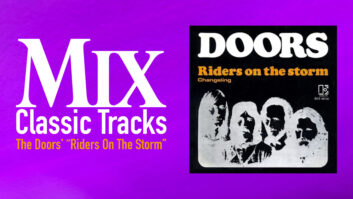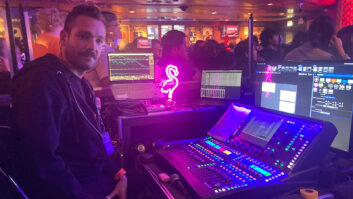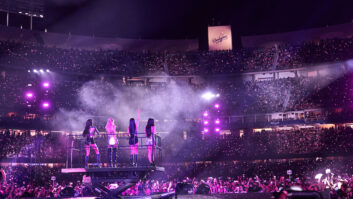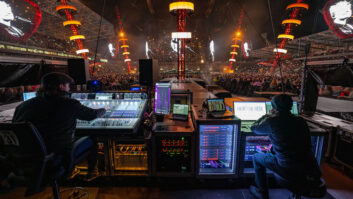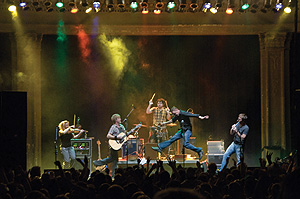
Gaelic Storm performing live
Photo: Billy Crofton
Gaelic Storm is out in support of their release Cabbage (Lost Again). Mix caught up with FOH engineer and production manager Pete Wildermuth.
How much gear are you carrying?
We are carrying much, much less gear than most bands on the road these days. After over a dozen years of solid touring, Gaelic Storm has figured out how to tour efficiently and effectively. Gaelic Storm plays many of the acoustic instruments that you would expect to find in a band focused on making rousing celtic and music: fiddle, steel-string guitar, highland bagpipes, uilleann bagpipes, tin whistle, accordion and hand percussion on congas and doumbek drums. What you might not expect to hear are electronic bagpipes and an electronic bass drum, which is triggered by a Roland KD8 Trigger Pad. That being said, the band doesn’t need amps and loads of equipment onstage to make the big sound that accompanies the high-spirited atmosphere of their live shows.

Front-of-house engineer Pete Wildermuth
The few racks of gear that we do tour with carry essential signal processing and our wireless systems. Guitarist Steve Twigger uses a Fishman Aura pickup on his Collings guitar, the output of which feeds a Shure ULX-1 transmitter and ULX-P4 diversity receiver to allow for absolute freedom to move about the stage. Twigger also uses a PreSonus Eureka Pro Channel Strip and a Yamaha AG Stomp to smooth out his sound. Fiddler Jessie Burns uses a Shure ULX wireless system to transmit the sound that is captured by her LR Baggs Violin pickup. Jessie is a huge fan of her Grace Model 101 preamp, which is the last piece in her signal chain. Lead singer and accordion player Patrick Murphy sings into a ULX Series wireless handheld with a Beta 58 capsule, and even though you can’t hold a wireless mic and play accordion at the same time, his accordion is also wireless for those moments when he’s not in front of the mic. Bagpiper Peter Purvis, who is at the opposite side of the stage from Jessie Burns, would feel stranded if his bagpipes weren’t also wireless. Having everyone fully wireless makes the show more interesting to watch and encourages spontaneity. There are always those few special shows where the band gets inspired to hop off stage and up onto the bar where they’ll play out the end of the show surrounded by the audience.
Of course, none of this would be possible if the band couldn’t hear themselves wirelessly, too. Our personal monitor system revolves around a Crest Audio X Series X 20RM analog monitor desk. The band is running right around 20 channels, so the board is a great fit and the internal XLR splitter allows us to roll into a venue, patch in our XLR fan-outs and move swiftly toward soundcheck. The advantage of our system is that it is built into a rack case with casters that is rolled out right onto stage. This allows the band to make necessary adjustments to their mixes onstage while keeping the touring crew to an efficient minimum, without the need for a full-time monitor engineer. The in-ear monitor system includes two PreSonus ACP-88s for compression before the mixes reach the Shure PSM 600 transmitters. The remaining channels of compression are used to keep certain instruments under control in the monitor mixes. Both Steve Twigger and percussionist Ryan Lacey are using custom-molded Ultimate Ears UE 10 Pros while the rest of the band is using Shure SCL-5s. A pair of small condensers serve as audience microphones so the band can maintain the intimate nature of their shows and interact with the crowd throughout the show.
Run me through the P.A. setup.
The band plays a very wide array of venues from medium-sized clubs, to elegant historic theaters, modern performing arts centers, amphitheaters and, of course, many, many outdoor festivals. It would be very difficult to tour with a system that would be well-suited to so many environments. We rely on house-provided FOH consoles, outboard gear and P.A. systems. I will encounter a wide array of analog and digital desks, and it’s an excellent way to stay sharp and to use my troubleshooting skills when I inevitably encounter the system that is out of phase, the bad insert cable or a channel strip that’s on the fritz. Digital consoles offer unparalleled power and flexibility, but for a band that isn’t running 48 channels every night, it makes a lot of sense to keep it simple. Nevertheless, we are able to maintain a consistent sound because we really have control of what’s happening onstage. We use our own selection of microphones, direct boxes and cable looms, and the band has their personal monitors dialed in so half the battle has been won before we even begin soundcheck. If I have to work a little bit harder out at FOH with an unfamiliar and less-than-ideal rig, that’s okay; those situations are what keep touring interesting!
What is the most important part of your mix and how do you achieve that?
With the unique combination of instruments in the band, the most challenging thing is to make the mix sound full, without sounding brittle or harsh. There is an abundance of upper-midrange frequencies, especially in the fiddle and bagpipes, that require some careful notch filtering. I find that cutting 4 kHz and 8 kHz on the bagpipes really helps to soften it up. I also find myself boosting a bit of low-mid with the ‘pipes. With no bass guitar in the band, I compensate for that by keeping the bottom end of the guitar as prominent as I can while being careful to cut just a bit of where it can get muddy, usually around 160 cycles. The lack of bass guitar is also made up for by the solid bass drum sound, which originates from a Roland TD-3 sound module. Finally, I place a Sennheiser e604 on the bottom of the Djembe to capture the bass notes that Ryan plays.
To keep vocals under control, while also allowing them to cut through the mix, I typically double-bus my vocal channels by assigning them to a pair of subgroups and also directly to the left/right mix. I use a stereo compressor or a pair of compressors inserted on the subgroup, typically with a 3:1 or 4:1 ratio. The compressed signal is blended with the direct, uncompressed signal, which offers so much more control. If I had my choice, I’d use a pair of dbx 160A compressors for vocals.
When you’re not on the road, where can we find you?
I’m currently in the process of buying my first house in Ashfield, Mass., with my wife, Jenny, so I am caught up in all the preparations and paperwork for such a significant event. It’s a beautiful old fixer-upper so I’ll have my hands full with renovations, but until then you can find me on my mountain bike exploring trails, in the basement working on a project or helping my wife with barn chores; we have two horses and a pony. Otherwise, I enjoy the occasional trip to visit family on Cape Cod and a day spent sailing.




